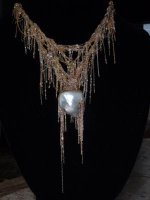DrTKStern
Natural Pearl Connoisseur
- Joined
- Oct 29, 2007
- Messages
- 374
Princess Yolanda article #3
Princess Yolanda article #3
No. 3 by Princess Yolanda
Assumption: "Shell" is referred to as the shell of a mollusk
Terms:
chonchiolin - (kong-ki' a-lin") a protein substance which is basis of
of a shell.
nacre - inner layer
shell - outer layer
perisotracum - outer layer only which starts out as a single homogenous layer. The rest of the shell is composed of calcium carbonate.
"Does the size of the mollusk determine the size of a pearl?" NO
"Does the age of the pearl affect the size of the pearl?" Yes and No
1. To the extend that pearl farms can determine implantation and harvest schedules, they can pretty much predict the size of their pearls based on the size of the implants and the number of years they keep the mollusks under water. Within these limits, they can also predict nacre thickness but there are always surprises.
2. In the wilds, due to the absence of an eyewitness, there is no way to document the age of a pearl based on its size or the estimated age of the mollusk. In the natural sequence of procreation, some small Moms can have large babies while some large Moms have surprisingly small babies. This pattern seems to follow the pearl producing mollusks in the wilds.
" What actually determines the growth of the pearl?"
The pearl mollusk's environment, be it salt or fresh water, contains Calcium ions. The molluscan bloodstream absorbs the calcium ions and transports them into the mantle. Calcium carbonate is absorbed by the conchiolin, the protein matrix secreted by the mantle. A fluid is discharged between the mantle and the shell. The composition of this fluid depends on the various substances in the blood tissues. It is what determines the matrix of conchiolin and the growth rate of the calcium carbonate crystals.
There are two forms of calcium carbonate crystals in shells: calcite and aragonite.
Have a nice day!
Princess Yolanda article #3
No. 3 by Princess Yolanda
Assumption: "Shell" is referred to as the shell of a mollusk
Terms:
chonchiolin - (kong-ki' a-lin") a protein substance which is basis of
of a shell.
nacre - inner layer
shell - outer layer
perisotracum - outer layer only which starts out as a single homogenous layer. The rest of the shell is composed of calcium carbonate.
"Does the size of the mollusk determine the size of a pearl?" NO
"Does the age of the pearl affect the size of the pearl?" Yes and No
1. To the extend that pearl farms can determine implantation and harvest schedules, they can pretty much predict the size of their pearls based on the size of the implants and the number of years they keep the mollusks under water. Within these limits, they can also predict nacre thickness but there are always surprises.
2. In the wilds, due to the absence of an eyewitness, there is no way to document the age of a pearl based on its size or the estimated age of the mollusk. In the natural sequence of procreation, some small Moms can have large babies while some large Moms have surprisingly small babies. This pattern seems to follow the pearl producing mollusks in the wilds.
" What actually determines the growth of the pearl?"
The pearl mollusk's environment, be it salt or fresh water, contains Calcium ions. The molluscan bloodstream absorbs the calcium ions and transports them into the mantle. Calcium carbonate is absorbed by the conchiolin, the protein matrix secreted by the mantle. A fluid is discharged between the mantle and the shell. The composition of this fluid depends on the various substances in the blood tissues. It is what determines the matrix of conchiolin and the growth rate of the calcium carbonate crystals.
There are two forms of calcium carbonate crystals in shells: calcite and aragonite.
Have a nice day!

